Posts Tagged ‘East Gippsland’
Monday, May 14th, 2012
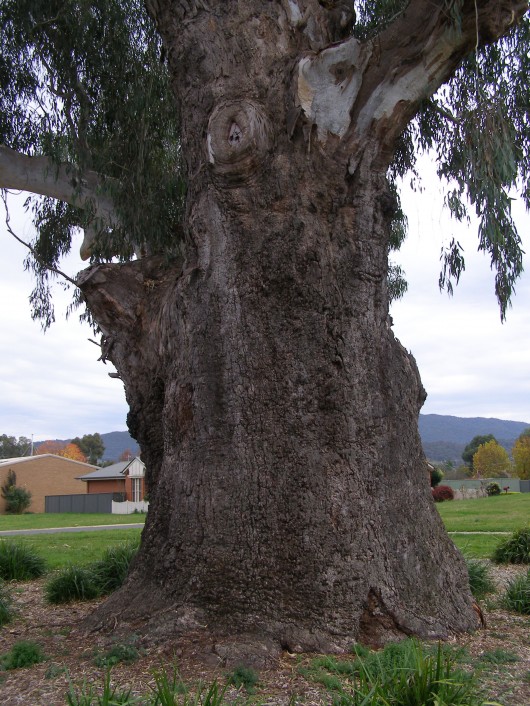 River Red Gum
(click image to enlarge) River Red Gum
(click image to enlarge)
.
Play music by Australia’s David Hyams: 
[Music source: ^http://www.milestogo.com.au/]
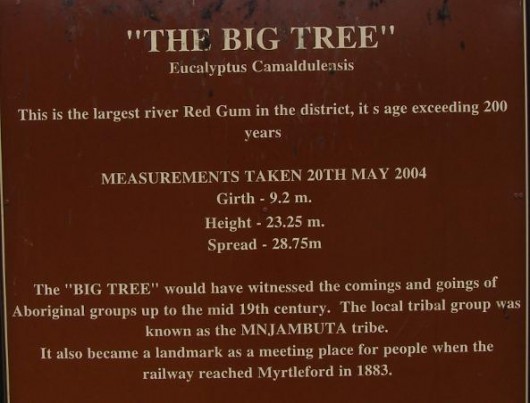
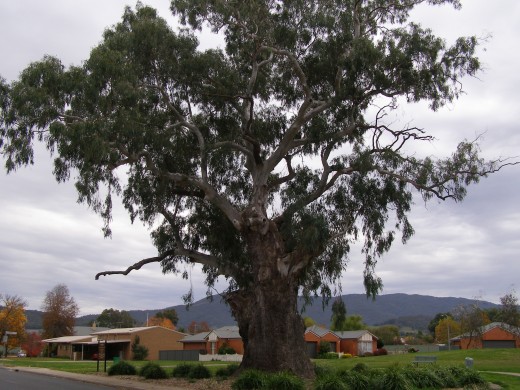 Myrtleford’s 200+ year old River Red Gum
(Eucalyptus camaldulensis) Myrtleford’s 200+ year old River Red Gum
(Eucalyptus camaldulensis)
.
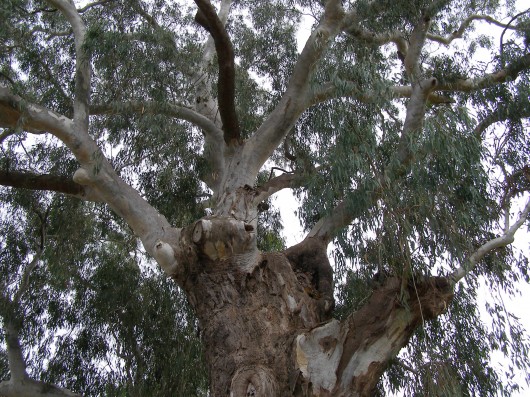 Native to riverine valleys particularly of heavy clay soils along river banks and on floodplains subject to frequent or periodic flooding across riverine northern Victorian and southern New South Wales.
Native to riverine valleys particularly of heavy clay soils along river banks and on floodplains subject to frequent or periodic flooding across riverine northern Victorian and southern New South Wales.
.
Most Australian trees, like native Australians, have otherwise been despised and slaughtered by Colonists…
 Indigenous Australians Indigenous Australians
.
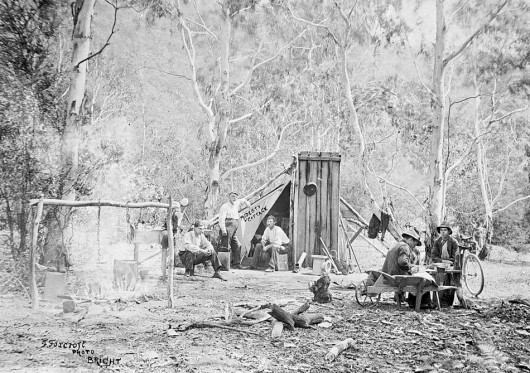 The township of Bright before the exotic trees.
In the 1890s when colonial miners exploited North East Victoria..
the Red Gum would have been just 80 years old.
. The township of Bright before the exotic trees.
In the 1890s when colonial miners exploited North East Victoria..
the Red Gum would have been just 80 years old.
.
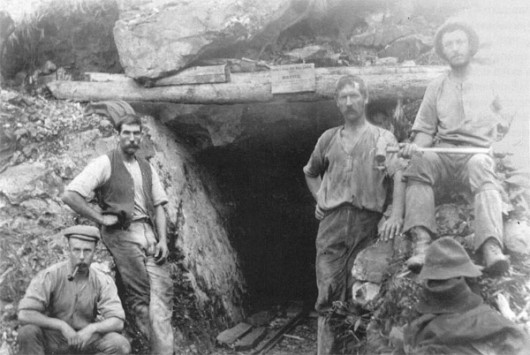 . .
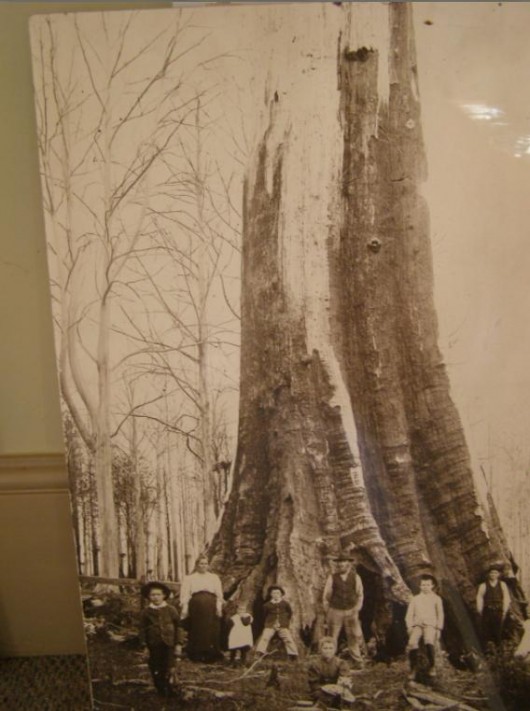 The ‘Penny Tree’
[Fumina, East Gippsland, Victoria, 1908] The ‘Penny Tree’
[Fumina, East Gippsland, Victoria, 1908]
.
..”As a result of the devastating bush fires which raged through Gippsland some 18 months ago, this Settler in the Fumina district was unfortunate enough to lose his home, and afterwards took shelter in this big hollow tree.
The space available was enough for 2 large beds, tables, chairs and sundry other furniture. Under the deft fingers of “The Lady of the Tree” it soon transofrmed into a comfortable home for the Family, until eventually replaced by a 6 roomed home some time later.”
[Source: The Weekly Times, 1908]
.
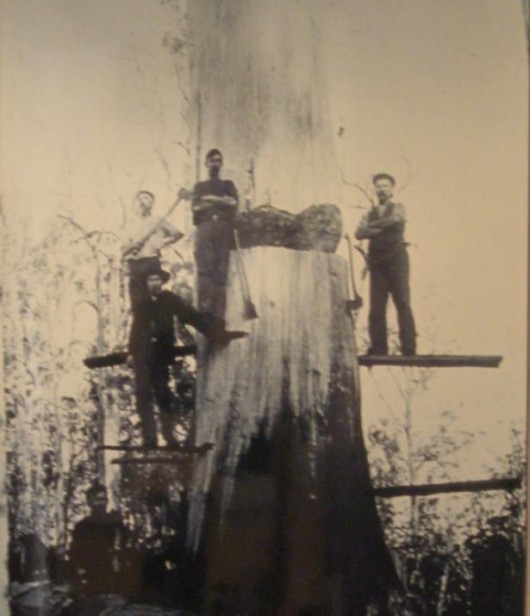 . .
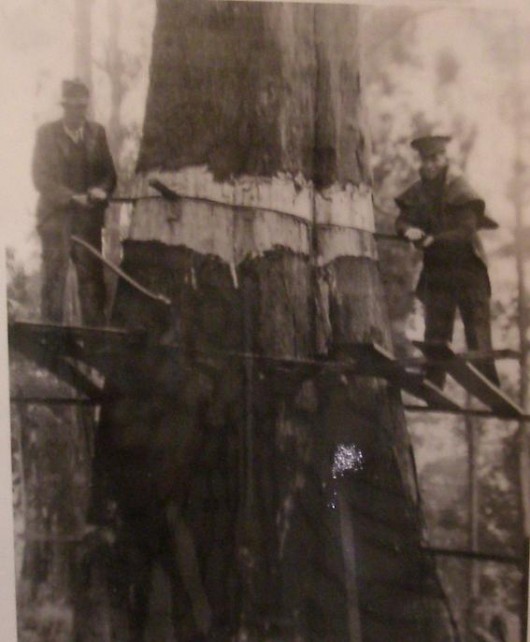
[Source: Forestry Museum, Beechworth, Victoria, Australia]
.
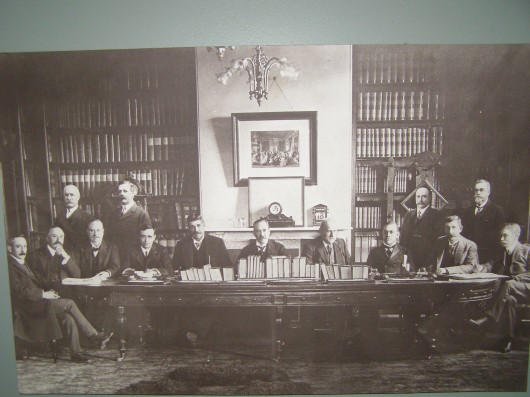 Victorian colonists driving ‘COLONIAL PROGRESS‘
(click image to enlarge) Victorian colonists driving ‘COLONIAL PROGRESS‘
(click image to enlarge)
.
Tags: Australia's old growth, Bright, colonial progress, East Gippsland, Eucalyptus camaldulensis, Fumina District, Logging, Mnjambuta, Myrtleford, North East Victoria, Penny Tree, River Red Gums, The Big Tree
Posted in Threats from Deforestation | 2 Comments »
Add this post to Del.icio.us - Digg
Saturday, August 27th, 2011
The following ultra-short article was initially published by Tigerquoll on CanDoBetter.net 20090507 under the title: ‘Premier John Brumby – a man of principle, a ‘year of action’ logging Old Growth at Bungewarr Creek‘
.
Senseless slaughter of Victoria’s Old Growth..another Brumby legacy for Victoria
29 April, 2009:
The result of senseless logging at iconic Bungewarr Creek, far East Gippsland. Loggers have desperately chainsawed magnificent stands of ancient Australian Eucalypts along Bungewarr Creek in East Gippsland as the woodchips, allowing our natural heritage to be sold out to the Japanese for a despicable $2.50 per tonne!
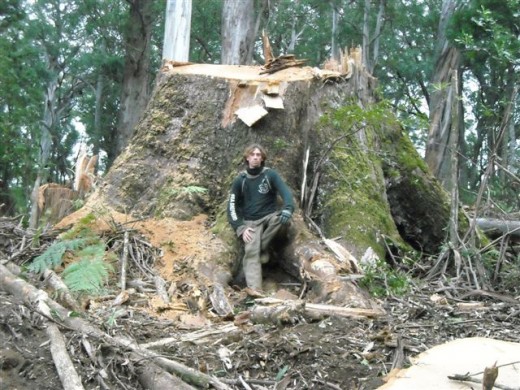
“Two protesters are ‘flying’ a platform located thirty metres up in the tree canopy”.. “this platform is cabled off to four logging machines, immobilizing them.”
First blockaded in 1994, Old Growth at Bungewarr Creek has been targeted by loggers ever since. Premier John Brumby simply cannot be trusted with Victoria’s natural heritage.
.
.
Subsequent Comments:
.
‘Sell the loggers not the logs’
On May 7th, 2009 Sheila Newman replied:
Maybe these stooges for big companies would get more money selling the loggers?
Sheila Newman, population sociologist
.
.
‘Rampant materialism and environmental destruction!’
On May 7th, 2009 Vivienne replied:
About 90% of what comes out of our old-growth forests ends up as woodchips to make paper, the majority of which is sent overseas. The “management plan” for Tasmania’s Upper Florentine Valley means a growing logging industry for wood chips, with a current price a mere $2.50 per tonne!
Despite the area being surrounded by mountains of the Tasmanian World Heritage Area, the Colonial ignorance of slash and conquer the bush has changed little since the last Tasmanian Tiger was captured there in the 1933.
All this so-called “sustainable forest management” is just thinly disguised eco-destruction by Tasmania’s logging industry.
We are bombarded with ecologically “friendly”, “sustainable” and “green” language, but the euphemisms are totally contrary to everything they claim!
We are encouraged to avoid plastic bags, turn off power when it is not needed, use energy-friendly light bulbs, save water, use public transport, but the benefits of these actions belie the fact that our governments continue to support the large polluters and industries that are adding to climate change and conservation threats!
Our leaders must be held accountable the rampant materialism and environmental destruction that our nation is succumbing to.
.
.
‘Logging contracter attacks Bungewarr protesters’
On May 9th, 2009 jim barton replied:
i have lost several thousand dollars in income due to the pathetic protests the greens have undertaken over the last 2 weeks in the bungewarr area. If you have a problem take it up with the state government directly or the vic forests office. No one will ever take you seriously while you are illegally chained to a machine or strung up a tree stopping the people who are there to make money to feed our familys. Do you honestly think the state government gives a shit while you are taking this sort of illegal action? The only people losing out are the loggers by taking away a slab of our income, the easily led pawns the greens send in to the protests that come out feeling like heroes but now have a criminal record for life. Also not to mention the tens of thousands of tax payer dollars that get spent on the police rescue squad coming from melbourne just to release the protesters and also the local police time wasted. Start using your brains and be a little more democratic and also start telling people the truth about our logging practices instead of just the lies you make up to sway the public to your way of thinking. Old growth forest dosn’t absorb carbon dioxide like you say so if you want to get technical we can say that we are helping climate change by replacing it with smaller re growth that with filter the atmosphere a lot more efficiently. This is a saw log driven industry, the pulp that goes for wood chips is what is left over from the tree after the saw log has been taken. Stop the lies and the pathetic protests because no one listens when you go about it in this way. Your protests are just an excuse for camping up the bush smoking dope, dancing around a fire by night, then during the day trying to fighting for a cause that not that many of them really know that much about.
.
.
‘State Government does not listen to decent protests!’
On May 9th, 2009 Jose replied:
Extreme protests are because our State Government is only interested in money and the votes of businesses, and jobs for forest workers. Extreme protests gets the public and the media’s attention. The income of loggers is a minor and short-term affair. These old-growth forests and trees have been here since Columbus discovered America, or before! They have TIME and GREATNESS on their side, and these stalwarts stand as sentinels against the wreckage that humans in power want to inflict on them, for a paltry $2.50 per tonne! They store massive amounts of carbon, and chopping them down is environmental vandalism. Get a job, Jim Barton! Nobody accepts the green-washing bulls**t our State government comes out with! They are all lies.
.
.
‘VicForests no different to Indonesian Timber Mafia’
On May 11th, 2009 Tigerquoll replied:
Illegal logging involves “wood harvesting, processing and trade that do not conform to law. Illegalities occur right through the chain from source to consumer, the harvesting procedure itself may be illegal, including corrupt means to gain access to forests, extraction without permission or from a protected area, cutting of protected species or extraction of timber in excess of agreed limits. Illegalities may also occur during transport, including illegal processing and export as well as mis-declaration to customs, before the timber enters the legal market.”
Other examples of illegal logging are:
* Under-reporting harvest volumes and tax payable
* Ignoring selective cutting guidelines
* Harvesting outside concession boundaries
* Falsifying log transport documents
* Accepting falsified log transport documents
Timber can also be considered illegal if the plantations are not properly managed.
This includes:
* Clear-cutting natural forest, then failing to replant
* Not planting at rates required to maintain long-term production
* Replanting with low-quality species
* Replanting at low density.”
SOURCE: http://www.abc.net.au/4corners/content/2002/timber_mafia/resources/resources_illegal_logging.htm
So perhaps Jim Barton can explain the forest impact difference between VicForests endorsed slaughter of Australia’s heritage old-growth at Bungywarr Creek and at Brown Mountain in East Gippsland and what the Indonesia’s Timber Mafia are doing?
.
.
‘More Lies’
On May 12th, 2009 jim barton replied:
Righto jose and tigerquoll lets get a few things straight. first and foremost, i have a job. i am a logger currently logging the bungewarr creek area incase you didn’t read my first piece properly. Secondly, tigerquolls new name is now guinea pig because thats what he looked and sounded like when he was running back for cover into the bush at last weeks tax payer funded protest when we wanted to talk to him. It is bullshit for you dole bludgers to say that loggers incomes are not an important issue when it comes to this arguement. That’s rich considering most of the protestors don’t have jobs and live off the money i pay in tax every week, therefor you are living off the tax money earned through logging old growth forests and that alone increases your carbon foot print when you trace it back! Like it or not the logging practices we undertake are as much as you may dislike the idea, legal. You may need a little thing the police call evidence if you want to go throwing unproven and rediculous claims at us. You can check every single log docket, boundary marker and all other relevant paperwork if you like. All you will find is a legal harvesting procedure that has complied with the legal requirements and documentation that vic forests and our state government has specified, planned and employed us under and therefor endorsed. You can throw your big words, lies and acusations around all you like but at the end of the day no laws are being broken apart from the ones you break by trespassing into a public safety area and holting work for a few hours. like i have said everyone is entitled to an opinion, maybe you need to voice yours through the proper authorities. Maybe then people will listen because illegal action will never conquer legal works. By the way, old growth trees have been proven not to produce oxygen after a certain age and also stop absorbing carbon dioxide. look it up. We do not falsify log dockets as that is what we are payed by. We do not underreport the amount of timber harvested for tax reasons as we are liable to penalties from vic forests if we do not cut the contracted volume of wood. We do not harvest outside boundaries as that can lead to penalties that in tern end up costing us money. Vic forests and the dse burn the finnished coupes to stimulate seed germination and growth (replanting). Areas are regenerated at rates to ensure that the area is sufficient for the next round of log harvesting. Finally, the correct species are replanted at the correct density to ensure the bush grows back to meet harvesting, legal and environmental standards. And to your final question guinea pig, our logging practices are not illegal due to the fact that the people in our crew comply with australias rules and regulations on the correct procedures for timber harvesting. Indonesias logging is illegal due to the fact that they enter an area to take timber without the correct permits and by buying the governments silence through kick backs from the profits of these illegal activities. Logging old growth is only illegal in your minds because you let emotion and centiment cloud your already hazey vision and it is a last desperate stab to try and lock more bush into national park. I Hope your all warm in your wooden houses tonight, on your cleared land to make way for that house and in your wooden bed and i hope that soft toilet paper that came from those trees dosn’t scratch your ass when this reply gives you all the shits!
.
.
‘Logging subsidised by tax-payer’
On May 13th, 2009 Anonymous replied:
You would have to be blind not to see that your line of work is unsustainable. That means that it costs more than it produces financially (the community subsidises logging). Do us all a favour and get a real job, or go on the dole and stop costing us all more than money.
.
.
‘Proud logger with job recycles but is realistic’
On May 13th, 2009 Jim Barton replied:
Thats the best you can come up with? Show me facts and figures on much it subsidises actual harvesting procedures.
Now if it is so unsustainable why are we logging areas that have been logged 2, 3 and up to 4 times over the last 100 years. Going on the dole would be the easy way out, wouldn’t it gutless anonymous? That is why all you loser protestors are putting your hands out every week. If you really care about the environment get out there and start working towards reducing wild dog numbers, helping to erradicate feral cats and why don’t you do something about the introduced vines that are strangling the native forests to death. The vines are spread through water ways that usually start their journey from up in the national parks that you lot won’t let anyone into to even maintain.
If you new anything about what you are talking about you would see this every time you are heading up the combienbar road dodging stubbies on your way to another pointless protest at bungywarr. But it is just easier to throw empty accusations once again without concrete evidence at the people who actually work for a living to feed their families instead of relying on someone else to feed them. I would like to say however, thank you to the person/s running this web site who have let me have a say on this subject. The greens have a terrible history of twisting what actually happens into a tangled web of what they think the public should hear, even as made up as a lot of it is. A healthy discussion is good for both sides, but eventually you will see the the country cannot survive on beautiful views, love and goodwill. unfortunately money makes the world go round and it is far to late to change that. Even climate change is a money making lie.
The earth has been changing temperature for millions of years and unfortunately buying a hybrid car and some solar panels is not going to make a lick of difference. To those who doubt my thoughts, show us all some hard evidence over the last million years of the temperature difference to now. As much as you may hate the idea the earth is undergoing a natural process that no one can control. Why i seem to recall a history lesson at school that showed tasmania, the mainland and indonesia was all one continent. With rising sea levels we now have more continents than we did millions of years ago and the sea will continue to rise no matter what we do. It is clearly a scare tactic to sway voters and the general public.
I am not a complete monster i still recycle and don’t litter but we have to be realistic.
.
.
‘National Association of Forest Industries (NAFI)’
On May 14th, 2009 Tigerquoll replied:
NAFI (or perhaps ‘Not Another Freakin Import’ provides a chainsaw scream for Australia’s scarce and depleting forests. Japanese woodchippers rape Aussie forests only to import A4 paper back to us at a profit. Aren’t we NAFI suckers?
NAFI is committed to ensuring clear fell logging and woodchipping of old growth has strong representation in political and public engagement to ensure this desperate slaughtering is supported in order to achieve the best possible outcome for NAFI and short contract loggers with no future prospects.
Australia’s forest industries, made up of remnant old growth habitat, plantations and any outlying unoccupied timber houses on the edge of towns, offer significant benefits for NAFI and no-neck loggers with no future prospects. By the year 2020 forest industries are projected to contribute:
* 16,000 short term forestry contracts and base pay with no security, no annual leave and no sick leave
* 81 million tonnes of Australian native forests sold out to Mitsui (the Japanese)
* $19 billion of Australia’s native farm sold out to the Japanese woodchippers – who have the hide profit from selling back to Australia white shiny A4 photocopy paper.
And so how is the multinational raper of Gippsland forests, Japanese Sumitomo Mitsui fairing these days? Well as at 10th April 2009, Sumitomo Mitsui reported its largest loss in six years and has desperately proposed to raise 800 billion yen in public offering.
Gippsland loggers have become losers in every sense. Contract logging to feed Jap woodchippers may pay the rent for a few months, but forget supporting a family or paying a mortgage! How many forestry workers called into the CES since the start of 2009?
.
.
‘Logging is not sustainable’
On May 14th, 2009 Vivienne replied:
Yes, you have a job! The point is , it is a dead-end type of job if you must continually destroy the habitat and ecosystems that support life. Most of our ancient forests end up at woodchips, for $2.50 per tonne! Nobody here is “putting their hands out”, but the logging industry should not be immune from retrenchment like other industries. You are right about other issues, about rubbish, feral animals and weeds. Retrenched loggers should be part of a new industry of “green” jobs of managing our native forests. There is so much good that could be done, as you have mentioned! While writing this, kangaroos are being massacred in Canberra as being “environmental threats”, but the real threats are humans, and the greed for profits! I think you have a conflict of interests with your source of income. The Government must take most of the blame for bending to these industries to get the rural votes. Our government cannot and will not address climate change because it is contrary to the growth mentality they are addicted to. Our materialistic greed is escalating, I believe, because our leaders know that our planet as such does not have another millenium left!
.
.
‘Earth is undergoing a natural process that no one can control’
On May 14th, 2009 Jose replied:
Yes, Jim Barton, the earth is undergoing a natural process that no one can control. There are things we can’t control, but there are also things we can! The massive plundering of our planet to accummulate riches and exports for continual growth is something we can control, if we get rid of self-interests and greed. Gaia will continue, the rock that rotates around the Sun, but it may not take kindly to the human “virus” it is infected with! Stephen Hawkings said humans were a bit of biological “scum” on a medium sized planet. We should not take our only home for granted! We do not have another to exploit! Our ecology is finite and so is Earth.
.
.
‘Twisting numbers into lies’
On May 15th, 2009 jim barton replied:
$2.50 a ton is not quite the truth. $2.50 a ton is what a machine operator is paid. You keep saying that wood chips are sold for $2.50 a ton, so show me a genuine document that states the chips are going for that price. $2.50 is a tonnage rate for being loaded onto the truck so technically they can’t be sent for that price. So if they are fallen for $3.50 a ton, snigged for $2.00 a ton and loaded for $2.00 ton, then the mills would have gone broke years ago wouldn’t they? Then you have the transport costs i believe that this is proof enough that you are scaring people again with more unproven lies. Yeh they are being loaded onto the truck for that price but no way sold for it.
.
.
‘Chainsaw operator should get a proper job that creates wealth’
On October 13th, 2009 Rousey replied:
I reckon that gutless whinging chainsaw operator or truck driver or whatever he is should stop taking subsidies and handouts from the government (Vicforests – never made a profit – any real company and you would have been out of a job years ago), get an education and get a proper job. Or at least stand up for something he believes. Other than the front bar of the pub.
.
.
‘These old trees do not have a monetary value!’
On October 13th, 2009 ecoEngine replied:
These trees are up to 600 years old. Their value is ecological and intrinsic. No value in $$ can justify their destruction. Income and jobs are temporal and temporary. We don’t chop up our houses when we need firewood. Destroying these heritage level trees, and protection from climate change, cannot be justified for whatever value! They are PRICELESS so disputing over dollars is irrelevant.
.
– end of article –
Tags: Brown Mountain, Bungewarr Creek, East Gippsland, Indonesia's Timber Mafia, old growth, Premier John Brumby, proud logger, save our forests, tigerquoll, VicForests, woodchip
Posted in Gippsland (AU), Threats from Deforestation | No Comments »
Add this post to Del.icio.us - Digg
Friday, August 26th, 2011
 Who does one believe?… Who does one believe?…
Greenwash Tick
.
.
.
Tuesday 23-Aug-2011:
‘Paper manufacturer loses green credentials’
by Liz Hobday, ABC News, 20110823, ^http://www.abc.net.au/news/2011-08-23/paper-manufacturer-loses-green-credentials/2851982/?site=melbourne, accessed 20110825]
.
The Wilderness Society says Australian Paper cannot meet environmental standards. The manufacturer of Reflex paper has lost part of its international environmental certification, after withdrawing from an audit of its wood supplies.

The Forest Stewardship Council was auditing Australian Paper, to check that the wood used to make Reflex paper is not sourced from high conservation value forests.
Luke Chamberlain from the Wilderness Society says the company withdrew from the process, because it cannot meet environmental standards.
“The makers of Reflex paper get their wood from the Victorian State Government native forest logging arm VicForests,” he said.
 “VicForests log in endangered species habitat. They log old growth forests in East Gippsland and the central highlands” “VicForests log in endangered species habitat. They log old growth forests in East Gippsland and the central highlands”
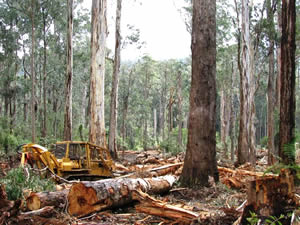
Australian Paper says its products are not sourced from high conservations value forests threatened by logging.
Shaun Scallan from Australian Paper says they withdrew because the audit process changed while it was underway.
“We pulled out because of a change in the definition of part of the standard late in the piece, which did not allow us enough time to then satisfy that changed definition,” he said.
.
.
Meanwhile the same Shaun Scallan of Australian Paper just the day prior on Monday 22 August 2011 posts his media release:
.
‘Australian Paper retains FSC Chain of Custody Certification’…?
by Shaun Scallan, Australian Paper, 20110822, ^http://australianpaper.com.au/media/2478/AP%20FSC%20audit%20release%20FINAL%20Aug%2022_2011.pdf, accessed 20110825
.
‘Australian Paper has successfully retained Forest Stewardship Council (FSC) Chain of Custody certification (FSC-C002059) in its latest audit. Auditor Rainforest Alliance confirmed that under the certification Australian Paper may continue to produce FSC-certified product based on sourcing of material from FSC-certified operations and recycled content, as allowed under the FSC rules for Mixed and Recycled product.
.
“We are pleased to have retained our FSC Chain of Custody certification,” Australian Paper CEO Mr Jim Henneberry said.
“Australian Paper has held Chain of Custody certification since 2006. However, we have decided to remove the Controlled Wood component from our certification at this time as there has been uncertainty around the interpretation of key elements of the standards.”
.
“Advice received by Rainforest Alliance from FSC International around the interpretation of the Standard was received after the physical audit had been completed. This left insufficient time for us to address and so we elected to withdraw Controlled Wood from our certification.” Mr Henneberry said.
.
Australian Paper remains committed to ensuring that fibre supplies come from internationally recognised, third party certified sources and also regards the Australian Forestry Standard and PEFC as benchmark certifications under this policy. The majority of wood supplied to Australian Paper is certified to the Australian Forestry Standard.
.
“We are also continuing to consult with a wide range of stakeholders as part of our Future Fibre Strategy review,” Mr Henneberry said.
“It is vital that we achieve the best balance between the environment, the health of regional communities and our ongoing competitiveness. We look forward to sharing outcomes from this review in due course.”
.
.
Meanwhile, we have the boss of Nippon Paper (the Japanese company that owns the misnomer ‘Australian Paper’) declaring Nippon Paper is going gang-busters to become a top global pulp and paper company…(at any cost?)
 ‘Since I was appointed president of Nippon Paper Group, Inc. in 2008, I have been pursuing “growth-oriented management.” This means exploring every possibility with a consistently positive stance, actively seizing opportunities, achieving the growth needed to become one of the top pulp and paper companies worldwide, as set out in the Group Vision 2015, and developing corporate value that meets the expectations of all stakeholders.’ ~ President of Nippon Paper Group, Yoshio Haga. [Source: ^http://www.np-g.com/e/about/president.html] ‘Since I was appointed president of Nippon Paper Group, Inc. in 2008, I have been pursuing “growth-oriented management.” This means exploring every possibility with a consistently positive stance, actively seizing opportunities, achieving the growth needed to become one of the top pulp and paper companies worldwide, as set out in the Group Vision 2015, and developing corporate value that meets the expectations of all stakeholders.’ ~ President of Nippon Paper Group, Yoshio Haga. [Source: ^http://www.np-g.com/e/about/president.html]
 . .
.
Meanwhile, the stated Charter of Nippon Paper Group includes:
.
‘6. Active involvement with environmental issues assures that…’
.
- ‘We shall promote afforestation projects, to create and make effective use of sustainable forest resources.’
- ‘We shall promote energy conservation, the use of wastepaper and other measures to effectively use resources that are limited in quantity.’
- ‘We shall manage and reduce all types of discharge and waste generated in the course of corporate activities.’
- ‘We shall research and develop manufacturing technologies, and products and services that are in harmony with the environment.’
.
[Source: ^http://www.np-g.com/e/about/charter.html#shead2]
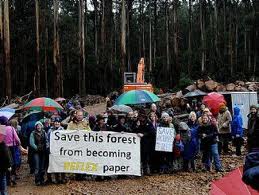
Editor: It is suspicious when a Japanese company is more than content to log and irrevocably destroy another country’s old growth forests, while Japan’s own old growth forests around Mt Fuji remain sacrosanct.
‘In spite of the abundant natural resources, logging is not commonly practiced in the forests of Japan. Japan Forests are venerated and protected since they provide essential soil cover and help in water conservation. All Species are encouraged to grow in the Forests in Japan , from the broad-leaved deciduous to the evergreen coniferous types. There are also many forests which grow near volcanic areas, destroyed and then rejuvenated every time an eruption occurs. The Aokigahara Forest at the base of Mount Fuji is one such forest. Locals as well as tourist camp, trek and hike through these dense forests of Japan to explore their unusual natural beauty.
‘Some Japan Forests are designated as Sacred Forests . These forests generally contain an ancient religious Shrine, usually worshiping the Shinto religion and are protected from trespassing and destruction. These forest shrines are still venerated as national treasures.
.
Some of the sacred forests in Japan are-
- The Forest of the Yahiko Jinja has many trees like the Cedar, Cypress and Oaks. The Shrine has a sacred Chinquapin tree as well.
- The Forest of Atsuta Jinja is an important Shinto Shrine, housing one the three important Shinto relics – the holy sword of Kusanagi-no-tsurugi. The forest has evergreens like the Japanese Camellia Sakaki, camphor trees, Ilex and Japanese Honeysuckle.
- The Forest of Kashima Jingu has over 800 species of trees like varieties of Cedar, Fir and Oak. The Kashima Jingu is an important shrine of the Kanto Area. The forest has been designated as a Wildlife Protection area for the rare birds in the region.
- The Forest of Shimogamo Jinja covers over 495 hectares and has many different species of deciduous trees like the Zelkova, the Elm and the Hackberry. The Shrine itself has 53 buildings which have been designated as National Heritage Architecture.
- The Forest of the Kirishima Jingu covers and area of 887 hectares. Located near the Mount Kirishima Volcano, the forest has been destroyed and then recovered for over 60 times.
- The Forest of the Kasuga Taisha is home to the beautiful podocarpus Nagi. The forest also contains many species of evergreens and shrubs. Trees like the Kasuga, the Andromeda and the Ichii also grow there. People from all over Japan visit the venerated shrine in the quarterly pilgrimages.‘
[Source: ^http://www.mapsofworld.com/japan/japan-tourism/forests-in-japan.html]
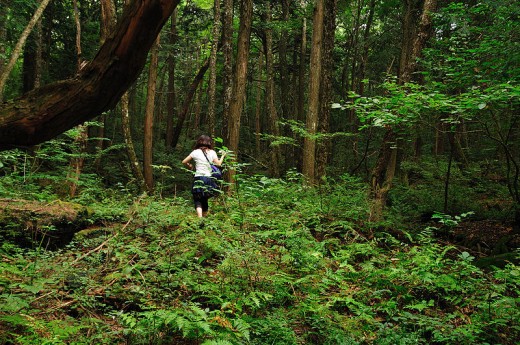 Japan’s sacred Aokigahara Forest Japan’s sacred Aokigahara Forest
.
Ethics question for Yoshio Haga (President of Nippon Paper Group):
What moral right do the Japanese have to consider their own native old growth Aokigahara Forest more sacred than Australia’s sacred native old growth forests such as those across East Gippland?
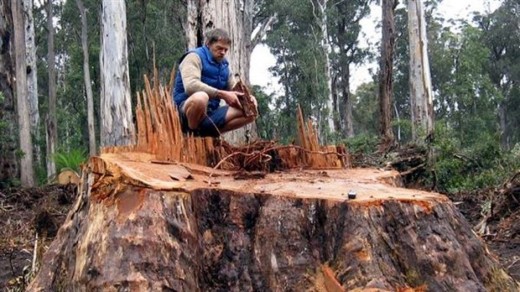 Stump of Brown Mountain’s sacred 600 year old Mountain Ash old growth tree.
It was logged by VicForests in November 2008 for Nippon Paper’s Reflex Paper. Stump of Brown Mountain’s sacred 600 year old Mountain Ash old growth tree.
It was logged by VicForests in November 2008 for Nippon Paper’s Reflex Paper.
.
.
In light of VicForests recent civil prosecution in the Victorian Supreme Court, Nippon Paper Group’s association with VicForests calls into question the reputation of Nippon Paper Group and its brand Reflex Paper:
.
‘VicForests has been stopped from harvesting certain coupes in the Brown Mountain forest in East Gippsland containing old growth forest
– habitat for rare and threatened species – until the completion of steps implementing the precautionary principle.’
.
.
.
‘Environment East Gippsland Inc v VicForests – The precautionary principle in action’
22 November 2010:
[Source: Blake Dawson (Lawyers), ‘Environment Matters’, 20111122, ^http://www.blakedawson.com/Templates/Publications/x_article_content_page.aspx?id=60457, accessed 20110825]
.
.
In Brief:.
- ‘The Victorian Supreme Court decision in Environment East Gippsland Inc v VicForests firmly embeds the approach to the precautionary principle laid down in Telstra Corporation Limited v Hornsby Shire Council (2006).’
- ‘The case makes it clear that the precautionary principle can be the subject of an enforceable obligation.’
- ‘The case also makes it clear that the precautionary principle applies both at the strategic and operational stages of a project or undertaking.’
- ‘The fact that VicForests complied with its forestry approvals was not enough to satisfy the Court that it had met its obligations with regard to the precautionary principle.’
.
‘In Environment East Gippsland Inc v VicForests [2010] VSC 335 conservation group Environment East Gippsland (EEG) won a landmark injunction against VicForests, a state-owned timber business with responsibility for commercial timber harvesting in Victoria’s state forests.
VicForests has been stopped from harvesting certain coupes in the Brown Mountain forest in East Gippsland containing old growth forest – habitat for rare and threatened species – until the completion of steps implementing the precautionary principle.
In this case, Justice Osborn of the Supreme Court of Victoria undertook a thorough analysis of the application of the precautionary principle in the context of a detailed legislative regime aimed at balancing biodiversity protection and commercial timber harvesting. The case embeds the approach to the precautionary principle laid down by Chief Justice Preston of the Land and Environment Court of New South Wales, in Telstra Corporation Limited v Hornsby Shire Council (2006) 67 NSWLR 256.’
.
The lead-up to the litigation
.
‘The Brown Mountain forests in Victoria’s East Gippsland contain old growth forests and provide habitat for rare and threatened species such as the Powerful Owl, the Spotted-tailed Quoll (mainland Australia’s largest marsupial carnivore) and the Long-footed Potoroo. However, these areas are also amongst the most productive timber harvesting forests in Victoria and play a crucial role in Victoria’s sustainable timber industry.
In 2006, the Victorian State Government committed to increasing the conservation parks and reserves within the broader Brown Mountain area. Nevertheless, in 2008 commercial logging in the Brown Mountain area began.
After numerous studies of the area indicated the presence of important threatened and rare species, EEG requested the Minister for Environment and Climate Change, Gavin Jennings, to make an interim conservation order to conserve critical habitat of the endangered Long-footed Potoroo, Spot-tailed Quoll, Sooty Owl, Powerful Owl and Orbost Spiny Crayfish at Brown Mountain. The Minister did not grant a conservation order, but instead increased the conservation area surrounding Brown Mountain.
Having failed to obtain undertakings from VicForests that it would not proceed to log the Brown Mountain coupes, EEG sought interlocutory injunctive relief. An interlocutory injunction restraining logging was granted by Justice Forrest on 14 September 2009 (see our article Environmental litigation heats up with some significant wins for public interest litigants in our 2 October 2010 edition of Environment Matters ), pending the outcome of the full proceedings before Justice Osborn in the Supreme Court of Victoria.’
.
The legislative regime
.
‘Logging of state forests in Victoria is regulated by a complex scheme of legislation, codes of practice, management plans and procedures, described by Osborn J as “labyrinthine”. The principal legislation includes the Forests Act 1958 (Vic) (Forests Act), Sustainable Forests (Timber) Act 2004 (Vic) (SFT Act), Flora and Fauna Guarantee Act 1988 (Vic) and Conservation, Forests and Lands Act 1987 (Vic).’
.
Responsibilities for timber harvesting and forestry management
.
‘VicForests is a state-owned corporation, established in 2004 to undertake the harvesting of timber in Victoria’s state forests. The Secretary to the Department of Sustainability and Environment (DSE) has overarching responsibility for managing state forests and timber harvesting within forests under the Forests Act.’
.
Legal challenge
.
‘EEG sought an injunction restraining VicForests from harvesting four coupes at Brown Mountain containing old growth forest. It also sought declarations that timber harvesting within the coupes by VicForests in accordance with the current forestry regime would be unlawful.
EEG argued that the current conservation measures for the Brown Mountain coupes did not meet the requirements of the regulatory system, which addresses the preservation of conservation values and in particular the protection of endangered species. EEG also argued that VicForests had failed to implement the precautionary principle.
VicForests took issue with EEG’s standing to sue. Further, it denied the presence of a number of endangered species and argued that the logging of the Brown Mountain coupes would take place under a legislative framework that adequately protects endangered species and would, therefore, be lawful. It also argued that it was DSE’s responsibility to stipulate any further requirements for habitat protection in accordance with the regulatory regime.’
.
EEG’s standing
.
‘Following the settled High Court authority that standing to bring such proceedings depends on the plaintiff’s “special interest” in the subject matter of the litigation (Australian Conservation Foundation v Commonwealth (2000) 200 CLR 591), Osborn J was satisfied that EEG had a relevant “special interest” because:
- EEG uses the coupes to a greater degree than the general public (for example, the group has a “Valley of the Giants Old Growth Forests Walk” through the affected coupes);
- EEG’s predecessor was involved in the consultative process for the formulation of the applicable forest management plan; and
- the government has previously recognised EEG’s status as a body representing this sector of the public interest.’
.
The precautionary principle [Ed: once again]
.
‘The VicForests case firmly embeds in Australian environmental jurisprudence the approach to the precautionary principle laid down by Chief Justice Preston of the Land and Environment Court of New South Wales, in Telstra Corporation Limited v Hornsby Shire Council (2006) 67 NSWLR 256 (Telstra). Justice Osborn’s decision in VicForests is the first Supreme Court application of the Telstra principles.
The precautionary principle is integrated throughout the Victorian forestry regime’s many instruments.
Following Preston CJ’s two-fold test in Telstra, Osborn J stressed that the precautionary principle is a test of common sense. There must be:
- a threat of serious or irreversible environmental damage; and
- scientific uncertainty as to the environmental damage.
Justice Osborn stated:
Once both of these conditions or thresholds are satisfied, a precautionary measure may be taken to avert the anticipated threat of environmental damage, but it should be proportionate … [The] degree of precaution appropriate will depend on the combined effect of the seriousness of the threat and the degree of uncertainty.
It is a “wherever practicable” test.
In practice, this meant that once the two-fold test was satisfied by EEG, VicForests had the onus of proving that the threat posed by logging the coupes did not exist or was negligible. Because it could not do this, the question then became:
- whether the threat was able to be addressed by adaptive management measures (in this case the requirement for surveys and management zone reviews); and
- whether the measure alleged to be required (here the permanent injunction against logging the coupes) was proportionate to the threat in issue.
Justice Osborn carefully examined the legislative regime and held that it is not intended that VicForests only apply the precautionary principle at the strategic planning stage:
VicForests is specifically required to apply it [the precautionary principle] having regard to the results of monitoring and research as they come to light during operations. … The requirements of the precautionary principle fall to be considered in the light of the whole of the evidence bearing on these matters as it now is and not as it was at the time VicForests completed planning.
Justice Osborn stressed, however, that the precautionary principle sits within a wider statutory regime that takes into account principles of sustainable development.
He held that unless VicForests complied with the requirements of the applicable Flora and Fauna Guarantee Act Statements and with conditions stated in the relevant allocation order (under the Forests Act) and the Timber Release Plan (under the SFT Act), logging at Brown Mountain would be unlawful.
This meant that VicForests could not rely on its current approvals to log the coupes because DSE had not, for example, changed zonings in the coupes to reflect the presence of threatened species. VicForests had an ongoing, active duty to apply the precautionary principle, which included responding to new information as it became available.
Importantly, Osborn J stressed that the precautionary principle can be the subject of an enforceable obligation.’
.
Outcome
.
‘Justice Osborn ordered that VicForests stop harvesting until various measures had been completed to respond to the detection of endangered species and to implement a precautionary approach with respect to their potential extinction. The required measures included:
- creating or amending special management zones, special protection zones and retained habitat areas to protect the Long-footed Potoroo, Greater Gliders and Yellow-bellied Gliders (as relevant);
- undertaking further surveys for the Giant Burrowing Frog, Large Brown Tree Frog and Spotted-tailed Quoll; and
- completing a current review of the Powerful Owl and Sooty Owl Management Areas,
to the satisfaction of the Director, Biodiversity Policy and Programs, DSE.
The difficulty for the Court in formulating its orders was that the power to act on the evidence of rare and endangered species and implement the required legislative and policy changes lies not with VicForests, against whom the injunction was sought, but with DSE.
Justice Osborn overcame this difficulty by stopping VicForests from logging until certain actions are undertaken, these actions being DSE responsibilities. VicForests had maintained throughout proceedings that it would comply with any changes to the regulatory regime made by DSE, and this was accepted by the Court.
.
Significance of the decision
.
This case firmly embeds the approach to the precautionary principle laid down by Chief Justice Preston in Telstra Corporation Limited v Hornsby Shire Council (2006) 67 NSWLR 256.
Justice Osborn’s decision makes it clear that:
- The precautionary principle can be the subject of an enforceable obligation.
- Parties having an obligation to apply the precautionary principle cannot demonstrate compliance with the principle solely through departmental approval of their actions or relevant approvals under the regulatory regime; the precautionary principle is an active obligation that applies throughout operations, requiring parties to respond to new information as it arises.
- The precautionary principle applies throughout all stages of operation, not just the strategic planning (or approvals) stage.
The decision has broader implications because:
- The precautionary principle is embedded in many other statutory regimes in Victoria and around Australia, apart from the Victorian legislative regime for forestry and the protection of endangered species. The decision has implications for any statutory regime in which the principle is enshrined.
- Although VicForest is a state-owned enterprise operating within a highly regulated environment, there is scope for the decision to be applied to other types of entities operating within industries where the precautionary principle is relevant.
Furthermore, a decision of the Supreme Court of Victoria has strong precedent value, and is likely to be adopted by the Supreme Courts of other States, and perhaps even higher courts or courts with federal jurisdiction.
.
Action points
.
Parties under an obligation to apply the precautionary principle need to be aware that:
- to implement the precautionary principle as per the principles laid down in Telstra, parties need to ask:
- is there a real threat of serious or irreversible damage to the environment?
- if yes, is it attended by a lack of full scientific certainty (in the sense of material uncertainty)?
- if yes, is the threat non-existent or negligible?
- if no, is the threat able to be addressed by adaptive management and is the measure alleged to be required proportionate to the threat in issue?
- the principle must be applied at both the strategic decision making stage of a project, and throughout the operational stage; and
- it may not be sufficient to simply obtain and comply with project approvals – parties need to proactively respond to new information as it arises throughout the operational stage.’
.
..
.
Further Reading:
.
[1] >Vicforests’ Ecological Genocide
.
[2] ‘Nippon buys Maryvale mill‘, by Ian McIlwraith, The Age newspaper, 20090217, ^http://www.theage.com.au/business/nippon-buys-maryvale-mill-20090216-89bu.html, accessed 20110826]
.
‘Paperlinx will take a $600 million hit on its half year results and the future of its Tasmanian operations is under review after last night unveiling the partial sale of its Australian papermaking business.
Japan’s Nippon Paper Group will buy most of Australian Paper, which includes the Maryvale pulp mill in Gippsland, for more than $700 million, including taking on attached debt and a three-year profit share agreement.
Money from the sale, expected to be completed in June, will go to reducing PaperlinX’s debt burden to about $340 million…’
[Editor: So Paperlinx was in debt to the Australian Tax Office by over a billion dollars? How can Australia’s pulp industry be profitable then?]
.
[3] Australian Paper Watch website (providing information about the logging of Victoria’s forests to make paper products such as Reflex by Nippon Paper and their ‘subsidiary’ Australian Paper), ^http://www.australianpaper.forests.org.au/
.
[4] Nippon Paper’s Maryvale Mill Upgrade, ^http://www.reflex.com.au/2008-Maryvale-Mill-Upgrade/
‘Australian Paper has a long history in the La Trobe Valley in Gippsland, Victoria, dating back to 1937 when established. Today, the Mill is Australia’s largest integrated pulp and paper operation. In response to global paper trends and changing consumer expectations for our products, Australian Paper (Nippon Paper subsidiary) embarked on a major upgrade of the Maryvale Pulp Mill in 2006 which was completed in December 2008. With an investment of $350 million, the upgrade significantly expanded the Mill’s production of bleached pulp capacity and delivered a range of safety, health and environmental benefits.’
.
[5] ‘Loggers, activists clash over forest‘, by Adam Morton, The Age newspaper, 20110817, August 17, 2011, ^http://www.theage.com.au/victoria/loggers-activists-clash-over-forest-20110816-1iwew.html
.
‘Conservationists have held up timber workers in a fiercely contested area of native forest on Melbourne’s fringe for nearly a month, chaining themselves to bulldozers and climbing trees scheduled for logging.
The protest, which has led to at least 10 arrests, is expected to reach a climax today as activists and local residents march into the logging coupe outside Toolangi in Victoria’s central highlands.
Protest organisers claim they have evidence the coupe is home to the endangered Leadbeaters Possum, which scientists say is under threat after Black Saturday bushfires wiped out up to half its habitat. But the Department of Sustainability and Environment says there has been no sign of live possums. Department spokeswoman Kim Payne said one tree in the coupe had hollows that showed evidence of possum use. That tree would be left standing, but the coupe did not meet the legal criteria of prime possum habitat and could otherwise be logged.
Sarah Rees, director of Healesville-based group My Environment, said it was cruel to think a possum could be protected by retaining a single tree while taking away the forest around it. She said logging was hurting central highlands communities.
.
”Tourism based on the state forest is far more important to the local economy than forestry and the two cannot co-exist,” she said.
The conflict over the Toolangi State Forest was the focus of a public meeting in the area late last week when logging opponents verbally clashed with forestry workers, who accused the activists of restraint of trade. One contractor said he had lost about $80,000 due to the protests.
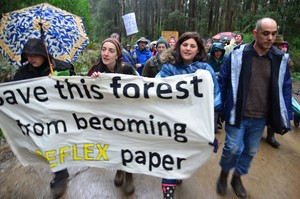
David Walsh, spokesman for state commercial timber agency VicForests, said the Toolangi protests had cost forest workers significant time. Only about a quarter of the 19-hectare coupe had been harvested. He said gates raised to ensure public safety had been damaged. ”VicForests believes these are legal harvesting operations which comply with the detailed legislative framework governing native timber harvesting in Victoria,” he said.‘
.
Editor: The legal doctrine of ‘restraint of trade’ sought to be applied in the commercial exploitation and destruction of old growth forests, is an invalid excuse. It is a contemptible euphemism for a ‘right to rape’ old growth ecology that is being contrived by commercial lawyers profiting from the exploiters ~ a case of the morally bankrupt collaborating with the damned.
[6] Ethical Paper website, ^http://www.ethicalpaper.com.au/
.
[7] My Environment website, ^http://www.myenvironment.net.au/
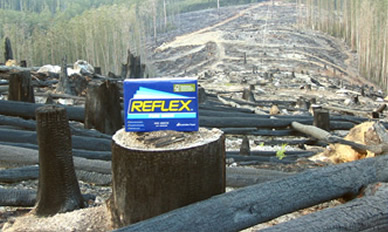
.
– end of article –
Tags: Aokigahara Forest, Atsuta Jinja, Australian Forestry Standard, Australian Paper, Chain of Custody certification, deforestation, East Gippsland, EEG, endangered species habitat, Environment East Gippsland, Environment East Gippsland Inc v VicForests, Flora and Fauna Guarantee Act, Forest Stewardship Council, Forestry Standard Certification, FSC, FSC audit process, FSC Chain of Custody Certification, FSC International, FSC-C002059, Future Fibre Strategy, Giant Burrowing Frog, Greater Glider, Greenwash Tick, Kashima Jingu, Kasuga Taisha, Kirishima Jingu, Large Brown Tree Frog, Leadbeaters Possum, Logging, Long-footed Potoroo, Maryvale Pulp Mil, My Environment, Nippon Paper Group, PEFC, Powerful Owl, precautionary principle, pulp and paper, Rainforest Alliance, Reflex Paper, restraint of trade, right to rape, sacred forest, Shimogamo Jinja, Shinto religion, Sooty Owl, The Wilderness Society, Timber Release Plan, Toolangi State Forest, TWS, VicForests, Yahiko Jinja, Yellow-bellied Glider
Posted in Gippsland (AU), Owls, Potoroos, Quolls, Reptiles, Threats from Deforestation | No Comments »
Add this post to Del.icio.us - Digg
Wednesday, July 20th, 2011
The following article was initially posted by Tigerquoll on 20090326 on CanDoBetter.net:
.
On Thursday 26th March 2009, four people were charged in their efforts to save East Gippsland old growth forests at Upper Delegate River from being chopped down.
 ‘The Goongerah Blockade’ ‘The Goongerah Blockade’
Protesting against logging of old growth forests in East Gippsland
….prepared to be arrested for habitat.
March 2009.
eco-warriors all!
.
Conservationists trying to conserve protected old growth forests have been charged with illegal conservation. Is Victorian Premier Brumby’s strongman stance seeking to emulate Mugabean democracy?
Is Brumby’s hypocritical law for conservationists that of prima facie guilt of conservation? Surely the need to conserve rare and remnant old growth forests makes conservation self-evident?
Premier Brumby’s DSE and VicForests under their own laws maintain these catchment forests under environmental protection legislation. Yet in breach of their own laws, Brumby’s environmental watchdogs have become lapdogs, watching loggers irreparably destroy these centuries-old Eucalypts and lay witness to Victoria’s disappearing natural heritage. It’s no different to Indonesia condoning destruction of Sumatran and Kalimantan rainforests.
When was the last time Brumby bushwalked through old growth Gippsland? Last year, or never?
A dedicated group of 20 forest conservationists prevented clearfelling in the upper Delegate River catchment up until now. “This particular old growth forest was recently surveyed by trained biologists and the result showed very high density of tree dwelling mammals”, said spokesperson for the group Carmel Roberts.
“The DSE is neglecting their responsibilities to protect endangered wildlife habitat, even though it clearly states in their Forest Management Plan that where high numbers of threatened species are found, habitat must be protected.
“The DSE are saying they are unable to protect these species’ habitat despite the logging being in clear breach of their legal obligations. The government puts more value on a months work by a few people than protecting endangered wildlife from extinction.
“In 2006, Premier Brumby made an election promise to protect the “last significant stands of old growth”. These forests are the very the last refuges for our rare species.”
“Since the devastation caused by the bushfires, East Gippsland’s forests are now even more critical to the survival of Victoria’s native species than before. Rare native wildlife could have been made locally extinct in other areas due to the fire damage.”
“Old growth forest habitats such as hollow-bearing trees, are critically important for the survival of these threatened species in Victoria. The logging industry can survive in plantations and regrowth, endangered wildlife can’t.”
.
.
Comments:
.
Woodchip mafia has Brumby well trained
March 28th, 2009 by ‘Blackdog’:
.
The Brumby government is truly the lapdog to the loggers. The woodchip mafia has him well trained. The rule book says the threatened species have to be saved. He destroys them and their habitat. The promise back in 2006 was to save the old growth – but all he’s done is cover for the increased targeting of prime areas.
Yep – no different to Indonesia or the Amazon. Only Brumby employs better media spin experts. Pity the public don’t wear it.
.
.
Lap dog governments are following Easter Island
On March 28th, 2009 Tigerquoll says:
Blackdog’s comments hit the mark.
I go further than black dog.
Lap dog governments are supporting destructionist loggers while publicly advocating environmental protection in another department.
This is gross hypocracy, a conflict of interest and corrupt.
I worry also that as more clever HSC graduates take on degrees in ‘communications’, which so frequently entices them into well paid jobs in government and corporate spin machines, that pure ethics is neglected at both senior school and at most university courses.
By denying our children skills and wisdom in worldly ethics, our children are being denied their rights to cope with ethical decisions. A degree without a base in ethics is a degree in propaganda, and don’t our lapdog governments lap them up?
Take the following example and ask why in our education system and supposed independent journalism, that Australians are more aware of the extremely rich celebrities than the natural and indigenous exploitation and neglect condoned by governmenst in Australia’s World region?
SOURCE: www.drmartinwilliams.com/conservation-and-environment/indonesian-forest-destruction-corruption-plays-a-role.html
“Since 1982, forest fires on a large scale in Kalimantan, Sumatra and Java have come with the onset of each dry season. A fire in Kalimantan in 1983, reportedly the largest in human history, destroyed 3.7 million hectares of rainforest, an area the size of the Netherlands.
In 1987, 2 million hectares, 1.4 million of primary rainforest, were destroyed in Kalimantan, Sumatra, East Timor, Sulawesi and mountain regions of Java.
In 1991 smoke and ash from fires blanketed Singapore, Malaysia and the Straits of Malacca, forcing Indonesia to call for international help.
Forest fires of this magnitude coincide with a rapid increase in logging and plantation activities which began in the early 1980s. In 1966, 82% of Indonesia’s land mass was covered by primary forest. By 1982 this had shrunk to 68%, and recent satellite photographs indicate that forest cover – including timber plantations – is now down to about 55%.
In late 1996, the Indonesian minister of forests said that 20 million hectares of forest were in a critical state and warned that this was increasing rapidly. The World Bank estimates 800,000 hectares of forest are lost each year.
Around 64 million hectares – one-third of Indonesia’s land mass – is devoted to commercial logging. In 1996 Indonesia became the world’s largest plywood exporter.
…
On September 9, Suharto reissued a 1995 ban on burning forest and called on the military to help enforce it. Companies were given until October 3 to prove they were not the culprits.
Laws allow up to 10 years’ imprisonment and a 100 million rupiah fine for polluters. Not one company, however, has ever been convicted. Even the environment minister, Sarwono Kusumaatmadja, admitted to Reuters on September 22 that environmental laws are not policed properly.
Soon after Suharto’s announcement, the number of fires increased, as companies rushed to clear as much land as possible before the deadline. Even if the deadline was strictly adhered to, it would only let companies finish clearing land at a time the normal rainy season would have forced them to do so.
…
But it is not just the greed of Suharto and the logging and plantation firms which has created this disaster.
Government investment and development policies which have promoted destructive land clearing practices are spurred on by market forces and capitalism’s endless drive for profit. Many of the projects were championed by and funded by institutions such as the World Bank and the IMF, which pressure countries such as Indonesia to increase exports.”
In 2009, we must learn from Easter Island’s ancient community and its unsustainable culture of nature exploitation which ended up condemning its civilization to extinction. Else, despite our iPods, in 2009 we risk the same fate.
.
.
Injustice rules the forests
March 30th, 2009 by Sheila Newman:
.
About time this shameful situation got coverage. I would like to see a story for EVERY charge against conservationists on candobetter.
It is quite true, as you say, that the Victorian Government frequently breaks the law in its forest activities. In fact it has practically torn up its own rule book.
Keep fighting!
.
– end of article –
Tags: Carmel Roberts, clear felling, conservationists charged, East Gippsland, Goongerah Blockade, John Brumby, Logging, old growth forests, Premier Brumby, tigerquoll, Upper Delegate River, VicForests, woodchip
Posted in Gippsland (AU), Threats from Deforestation | No Comments »
Add this post to Del.icio.us - Digg
Thursday, August 26th, 2010
by Editor 20100826.
East Gippsland, Victoria April 2009:
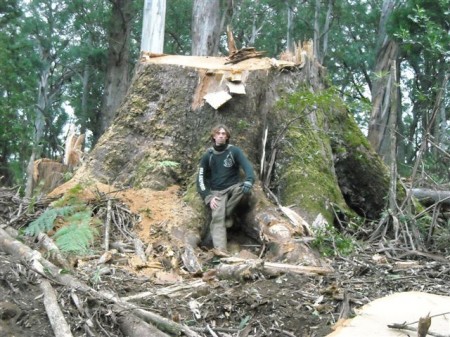 The senseless killing of a 500+ year old rare surviving Eucalyptus regnans
by VicForest contractors in April 2009.
( Photo courtesy of Environment East Gippsland) The senseless killing of a 500+ year old rare surviving Eucalyptus regnans
by VicForest contractors in April 2009.
( Photo courtesy of Environment East Gippsland)
Logging halted at iconic Bungywarr Creek (East Gippsland, Victoria, Australia)
29 April, 2009
‘Today independent forests conservationists are protecting ancient forests from logging in far East Gippsland.
“Two protestors are ‘flying’ a platform located thirty metres up in the tree canopy”, says spokesperson for the group, Ms Lauren Caulfield. “This platform is cabled off to four logging machines, immobilizing them.”
The tree-top protestors are supported by twenty-five forests conservationists on the site.
Bungywarr Creek was first blockaded in 1994, and has remained a contentious logging site ever since.
“Bungywarr Creek forest was identified as iconic almost two decades ago. The old-growth that remains at Bungywarr should be included in the Brumby government’s next round of forest protection”, said Ms Caulfield.
Earlier this month it was revealed that forests like the magnificent stands along Bungywarr Creek are sold to export woodchipping companies for less than the price of a Mars bar – a mere $2.50 per tonne.
“Selling our valuable and carbon-rich native forests for the price of a fast food snack is not making the best financial returns to Victorians”, said Ms Caulfield.
“For VicForests to continue to woodchip the remaining 8% of Victoria’s old-growth forests under Mr Brumby’s watch is a disgrace. Victorians expect and deserve management of our forests for a truly sustainable future.”
“Protecting nature is one of the most important ways to fight climate change”, continued Ms Caulfield. “The forest at Bungywarr Creek will do a better job fighting climate change if it is left intact and able to suck carbon dioxide out of the atmosphere.”
“While the Brumby government dithers on delivering the ageing 2006 old-growth forest promise, logging at Bungywarr Creek is making climate change worse”, concluded Ms Caulfield.”
[Media Release courtesy of Environment East Gippsland]
© The Habitat Advocate Public Domain
Tuesday, March 16th, 2010
Victorian Government’s VicForests is attempting to log old growth forests at Brown Mountain in East Gippsland, despite Brown Mountain being confirmed habitat for threatened and vulnerable wildlife. Local not-for-profit environment group Environment East Gippsland has commenced proceedings against VicForests in the Supreme Court of Victoria asking the Court for a permanent injunction to stop VicForests from logging Brown Mountain.
.
Reports:
(most recent at top)
‘The Brown Mountain landmark trial has concluded in the Supreme Court on Thursday 25th March – after a 16 day trial.’
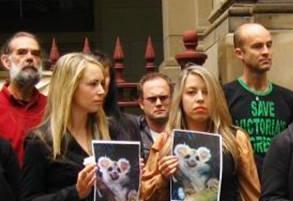
© Environment East Gippsland 2010 ^ http://www.eastgippsland.net.au/
East Gippsland residents outside Victorian State Parliament in early 2010
protesting against the Victorian Government’s immoral and illegal logging and scorched earthing
of old growth forests of Brown Mountain in East Gippsland Victoria, Australia.
.
The photos show a Greater Glider [Petauroides volans]. The Greater Glider is strictly nocturnal, and largely solitary, arboreal species of undisturbed eucalypt-dominated woodland habitats. It is endemic to south eastern Australian forests including Brown Mountain and its population is decreasing largely due to land clearing for agriculture, logging, and bushfires.
[Source: Environment East Gippsland, 20100327, ^http://www.eastgippsland.net.au/]
.
‘Justice Osborn has reserved his decision. It could take anywhere from one month to six months to hand down a finding, but of course we are hoping sooner.
The four week trial has been marked by finger-pointing between government logging bodies VicForests and DSE about who is responsible for endangered species. The behavior of those charged with protecting our wildlife has been exposed to public scrutiny and the Supreme Court’s enquiry.
We believe the government doesn’t survey for endangered wildlife before they log old growth forest, because they don’t want to find anything that would prevent logging. The Court heard that VicForests doesn’t employ wildlife experts, and EEG has argued that both VicForests and the DSE sideline the opinion of the government’s biodiversity unit. We now hope the Minister is fully informed about the very high conservation values in this area.
EEG presented evidence of a new species of crayfish in Brown Mountain Creek, plus experts claiming the stands of old growth are high quality habitat for two species of rare frogs, and the Spotted-tailed Quoll. The evidence for the Spotted-tailed Quoll was heart-breaking – the three last remaining viable colonies are in East Gippsland.
This case has been all about whether irreversible damage would be caused by logging. And as our legal team stated:
“You can’t get damage that is more irreversible than extinction.”
The outcome of this case is important for the protection of wildlife in other stands of high conservation value native forests under threat of clearfelling.’
.
.
‘The Brown Mountain landmark trial has begun!’
[Source: Environment East Gippsland, 20100315, ^ http://www.eastgippsland.net.au/]
.
‘After months of preparation, our legal team and supporters have gathered in Sale and begun the two-week Brown Mountain landmark trial.
Everything is going very well so far. It’s difficult to report on a hearing that is in progress, particularly since we are the plaintiff, so this article might lack a few things.
Our lead barrister, Debbie Mortimer SC, spent Monday afternoon and Tuesday morning in Court outlining what we say are the facts and the law, in a fascinating opening submission.
She spoke about the beautiful native wildlife that is central to our case, and the Court was treated to large pictures of the critters. It was almost surreal, but quite appropriate in our view, to see a team of lawyers in black gowns and wigs defending the furry, the feathered, the cray and the frog.
She said that VicForests has a number of legal responsibilities towards the environment, including endangered species, and that those responsibilities are inconsistent with logging at Brown Mountain.
For a more detailed summary of the first day’s hearing, read this excellent article by The Age journalist Kate Hagen, who is attending the hearing Click here Journalists from ABC Radio and Win TV (channel 9) are also attending the hearings.
VicForests’ lead barrister Ian Waller SC started outlining VicForests’ case this afternoon. When Court adjourned today, he said he still had about an hour to go, so we haven’t got the full picture yet.
But generally speaking he contended that VicForests’ responsibility to the environment wasn’t anywhere near as strong as we made out, and was balanced by its requirement to create economic and social benefits. He said that, to the extent to which VicForests has responsibilities to the environment and native wildlife, it has fulfilled them.
Today (Wednesday), Justice Osborn and the legal teams are having a look at Brown Mountain first hand. It’s not just a bushwalk, though; they will observe first hand some places and concepts about forests, logging and post-logging practices that will later on be discussed in Court.
On Thursday morning, VicForests’ opening submissions will finish, then Environment East Gippsland will bring out our witnesses.’
.
Fate of native Forest Hangs on ‘David v Goliath’ Court Case
Source: Environment East Gippsland, (EEG), 20100301, ^http://www.eastgippsland.net.au/
.
Environment East Gippsland Inc (EEG) v Vic Forests Brown Mountain Court Case, Sale, Monday, March 1
‘The fate of a native forest with trees dating back to Joan of Arc’s time is at stake in a Supreme Court case to be heard at the Victorian centre of Sale from Monday (March 1).
‘The landmark Brown Mountain case has national implications for all native forests in Australia and major political implications, with the green vote likely to be vital for both State and Federal Labor Governments in an election year – which is also the UN’s Year of Biodiversity.
‘In a David and Goliath battle, Environment East Gippsland (EEG) is seeking to stop state-owned logging monopoly VicForests from clear-felling Brown Mountain, a rich and ancient forest which is “chockablock” with threatened and endangered species.
‘The action marks the first time a Victorian court has been asked to grant a permanent injunction against state-sanctioned logging. It will also raise the fundamental conflict in Australia’s Regional Forest Agreement – where the State Government charged with protecting the forests is also the logger.
‘That was underlined in Victoria last year when Environment Minister Gavin Jennings gave the go-ahead to logging at Brown Mountain, declaring there were no threatened species in there. That very morning an EEG camera captured footage at Brown Mountain of a Long-footed Potoroo, one of Victoria’s most endangered species.
‘In the absence of government protection, EEG was forced to take legal action to defend the forest – an enormous and costly step for a community group.
‘In an Australian first, EEG last year won a temporary injunction on logging at Brown Mountain, ahead of the full hearing, with Supreme Court Justice Forrest comparing images from the forest to the WW1 battlefields of the Somme. But even if successful with their action, conservationists anticipate the Victorian Government may favour the logging industry and over-ride the court’s decision as has happened in previous high-profile cases in both Victoria and Tasmania.’
.
.
Brown Mountain Background
Source: Environment East Gippsland ^http://www.eastgippsland.net.au/
.
‘Brown Mountain, in East Gippsland in Victoria, contains old growth forest with ancient trees, one carbon-dated to 600 years old. It is prime habitat for threatened species including the Long-footed Potoroo, Spot-tailed Quoll, Sooty Owl, the Large Brown Tree Frog, the Square-tailed Kite, and the Giant Burrowing Frog. It is also a hotspot for arboreal mammals, like the Greater Glider and the Yellow-bellied glider.
‘Environment East Gippsland (EEG) alleges that logging four coupes on Brown Mountain is unlawful because it breaches provisions to protect endangered and threatened species in the Victorian Sustainable Forests (Timber) Act 2004 and the Flora and Fauna Guarantee Act 1988. In particular EEG says that VicForests has failed to comply with the Code of Practice for Timber Production 2007.
‘In the 2006 election, the Bracks Labor Government promised to protect “the last significant stands of old growth currently available for logging”. Brown Mountain should clearly have been included but, instead, 20 hectares were logged in summer 2008-09. Threatened species surveys triggered a moratorium in February 2009 followed by more surveys over winter and spring and, in August 2009, an EEG survey camera recorded the presence of a Long-footed Potoroo, one of Victoria’s most endangered species, despite the government’s declaration – earlier that same day- that there were NO threatened species at Brown Mountain.
‘In September 2009, EEG successfully obtained an interim injunction against VicForests to prevent logging in the coupes. In granting the injunction, Justice Forrest likened photographs of logging to ‘pictures of the battlefields of the Somme’.
‘Already the case has delivered important precedents:
- The Supreme Court refused VicForests’ application for up to $163,000 in security from EEG before a court injunction was granted to stop logging on Brown Mountain. Having to pay such a large sum would have stopped the community group being able to challenge critical habitat logging.
- The interim injunction, granted late last year, was also a groundbreaking decision because no Victorian court has ever ordered an injunction on logging before.
‘However there are concerns that the Victorian Government could override a logging ban, if the EEG case is successful.
‘Greens Leader Bob Brown successfully brought a court case to halt logging at the Wielangta forest in Tasmania because it threatened the endangered Swift Parrot, Tasmanian Wedge-tailed Eagle and Wielangta Stag Beetle. Then Prime Minister John Howard and Tasmanian Premier Paul Lennon amended the Regional Forest Agreement to permit logging to continue.
‘In 1998, logging at Goolengook in far eastern Victoria, the site of Australia’s longest running forest blockade from 1997 to 2002, was found to be unlawful because it was within a protected area next to a Heritage River. The Victorian government changed the law retrospectively to make the logging legal.’
.
.
Member’s Statement: VicForests – Brown Mountain old growth forest
SOURCE: Victorian Greens, 20090402, ^http://mps.vic.greens.org.au/node/1057
.
‘Ms PENNICUIK (Southern Metropolitan) — The Waikato Radiocarbon Dating Laboratory at the University of Waikato in New Zealand has confirmed that a tree cut down by VicForests in the Brown Mountain old-growth forest was between 550 and 600 years old. Until now foresters have claimed that these large trees were between 200 and 250 years old. Others have assumed that between 300 and 400 years would be the age limit before the trees succumb to rot. The tree was young when Joan of Arc lived and Christopher Columbus discovered America. It measured 11 metres around the stump close to the ground. Other trees on Brown Mountain have girths of 12 metres and more and could between 700 and 800 years old. They would have been mature when Marco Polo travelled the world. These trees are ancient relics and part of our precious national heritage.
‘VicForests and the Brumby government cannot replace these trees once they are cut down. They are logged on a 50-to-80-year rotation. It would take until 2600 AD for a tree to grow to the same size.
In 2006 Premier Brumby promised to protect the last significant stands of old-growth forests. Since then hundreds of hectares of these ancient forests have been cut down. It is not good enough for the government to claim that VicForests is independent and that the government can do nothing to save Brown Mountain. The government must act now to protect all remaining old growth forests in East Gippsland.’
.
.
Brown Mountain to stay green – for now
SOURCE: The Wilderness Society, http://www.wilderness.org.au/campaigns/forests/brown-mountain-to-stay-green-2013-for-now
.
‘Brown Mountain, in Victoria’s East Gippsland, is home to magnificent old-growth trees as well as endangered species like the Orbost spiny crayfish and the Long-footed potoroo. ‘One of the giant Brown Mountain trees that will hopefully be saved by the Supreme Court Injunction.
(Photo: Luke Chamberlain)
‘One of the giant Brown Mountain trees that will hopefully be saved by the Supreme Court Injunction.
(Photo: Luke Chamberlain)
.
‘But despite previous promises from the Victorian government to protect the last significant stands of old-growth forests in the state, Brown Mountain still has no protection against logging by VicForests.
‘Early in 2009, things were looking dire. Ignoring community outrage, VicForests’ bulldozers continued to destroy trees as old as 500 years.
‘Supported by the Wilderness Society, along with many concerned residents, volunteers and other concerned Victorians, Environment East Gippsland brought a last-minute court injunction against the logging at Brown Mountain.
‘Environment East Gippsland is Victoria’s longest running community forest group working solely for the protection of Victoria’s last and largest area of ancient forest in the state. Environment East Gippsland drew a line in the sand, and submitted for a court injunction to halt the logging.’VicForests, the Victorian Government’s commercial logging agency, stood up in court and argued for logging to begin as soon as possible.
Incredibly, VicForests said that it is not their responsibility, nor is it possible for them to comply with endangered species legislation!
‘Supreme Court judge Justice Jack Forrest commented on photographs showing the ”apparent total obliteration” of an old-growth logging coupe in Brown Mountain and subsequent burning off, saying they reminded him of the battlefields of the Somme.
”To put it bluntly, once the logging is carried out and the native habitat destroyed, then it cannot be reinstated or repaired in anything but the very, very long term,” he said.’
An injunction against logging was granted just in time. But an expensive trial over the issue will be heard in March. The Brown Mountain forests will need all the help they can get.
.
Minister ‘on two fronts’ in forest
SOURCE: Kate Hagan, The Age, 20100303, ^http://www.theage.com.au/victoria/minister-on-two-fronts-in-forest-20100302-pgg1.html
.
‘Environment Minister Gavin Jennings moved to protect significant areas of old-growth forest in East Gippsland at the same time as releasing some of it for logging, a court has heard.
‘Ian Waller, SC, for the state government’s commercial timber agency VicForests, said the minister announced new parks and reserves in the vicinity of Brown Mountain last year along with other measures to protect threatened species in the area. ‘They included a 100-metre buffer zone around Brown Mountain Creek and the retention per hectare of at least five hollow-bearing trees, which are important for habitat and breeding, where they were present in sufficient numbers.
‘VicForests is defending itself against a claim by Environment East Gippsland that logging of about 60 hectares at Brown Mountain would breach legislation aimed at protecting endangered and threatened species.
In an opening address yesterday to the Supreme Court sitting at Sale, Mr Waller said much of the newly protected area had never been logged, despite claims to the contrary by the environment group. ‘He said VicForests was meeting its obligations under various pieces of legislation and took a great deal of care in preparing its timber release plans, which had to be approved by the secretary of the Department of Environment and Sustainability (DSE) before logging could occur.
“‘It is not a random exercise by which areas of forest are deemed suitable for harvesting and only then checked for difficulties,” Mr Waller said. ”The entire process from beginning to end is one of checks and balances, where precautions are observed in identifying areas to be harvested as well as the manner in which harvesting is to occur.”
Mr Waller said it was the DSE, and not VicForests, that had the power and responsibility to create special protection zones where they were warranted. He said that logging might not pose a risk to the long-footed potoroo, listed as endangered by the federal government, because surveys after logging showed prevalence of the species had increased. Mr Waller said there was evidence that factors other than logging were threatening spot-tailed quolls, since the species was not secure even in areas of plentiful habitat. He said the guaranteed survival and flourishing of flora and fauna, as specified in legislation, was an ”aspirational goal” rather than an enforceable requirement. ”If a complete and utter guarantee had to be enforced in all respects it may be that harvesting would cease absolutely,” he said. ”Yet it is obvious the regime is to promote and allow harvesting.”
The trial is due to continue before Justice Robert Osborn, who today will view the contested site.’
.
.
Logging ‘a threat to wildlife’
Source: Kate Hagan, The Age, 20100302, http://www.theage.com.au/victoria/logging-a-threat-to-wildlife-20100301-pdlh.html
‘STATE-SANCTIONED logging of old-growth forest in East Gippsland poses a risk to threatened and endangered species and is at odds with the government’s own legislation, an environment group has said.
Environment East Gippsland is suing VicForests, the government agency responsible for logging in state forests, over plans to log about 60 hectares at Brown Mountain, which greens and the timber industry see as a symbolic battleground.
The group won an injunction last year preventing logging in the area before the trial, which began in the Supreme Court sitting at Sale yesterday.
The group acted after Environment Minister Gavin Jennings lifted a seven-month moratorium on logging at Brown Mountain, saying government scientists had found no evidence of endangered species there. But in an opening address yesterday, Debbie Mortimer, SC, for Environment East Gippsland, said VicForests relied on ”desktop planning”, using often outdated records that were at odds with evidence from field experts on the ground.
She listed nine species in the area that were recognised as being ”in a demonstrable state of decline” and prone to extinction, including the square-tailed kite, powerful owl, spot-tailed quoll and giant burrowing frog.
She said the long-footed potoroo, which the federal government listed as an endangered species, was particularly vulnerable.
”To an outsider it’s tempting to characterise this as a case about trees and whether they should be cut down,” Ms Mortimer said. ”In our submission that is to see this forest only as a kind of farm … for the purpose of harvesting trees.
”Our case is to see it as an ecosystem that grows and decays on its own cycles. Flora and fauna depend on it. It is complex and not fully understood.”
Ms Mortimer said logging in Brown Mountain was incompatible with a ”suite of legislation” enacted in Victoria aimed at protecting and conserving biodiversity.
She said the legislation was ”not intended to turn tracts of forests into islands where isolated populations of species inevitably lack biodiversity and the optimal breeding conditions and habitat range to recover and flourish.
”We do not dispute that native forest logging involves very different, frequently competing interests. What we seek to demonstrate is that logging of old-growth forests inhabited by many threatened species … under the present administration by VicForests favours logging in a way that the legislative and regulatory scheme does not envisage or allow.” She said forests were a ”community resource” that belonged to all Victorians.
The case before Justice Robert Osborn is due to continue today, when lawyers for VicForests are due to respond. ‘
.
‘Old-growth trees logged at Brown Mountain over 500 years old’
Source: The Wilderness Society, 20100301, ^http://www.wilderness.org.au/campaigns/forests/old-growth-trees-logged-at-brown-mountain-over-500-years-old
.
‘The Brumby government’s 2006 policy to protect old-growth forests in East Gippsland has been put to shame by VicForests who has been caught out logging trees over 500 years old.
In a state first, radiocarbon dating has confirmed that a tree logged and killed at Brown Mountain began growing before Christopher Columbus ‘discovered’ the Americas. The carbon sample shows that there is a 68% chance that the tree started growing between 1435 and 1490 AD, and it is believed that there are even older trees being logged.
In 2006, the ALP state government promised to protect the last significant stands of old growth forests. In a move that can only be described as environmental and political vandalism, VicForests sent the bulldozers into the first of three logging coupes at Brown Mountain in October last year.
Recent flora and fauna surveys have revealed that Brown Mountain is extremely rich in arobreal species and contains endangered species such as the Orbost Spiny Crayfish and the Long-footed Potoroo.
However, VicForests continues to ignore community calls to end the logging at Brown Mountain and has refused to remove two more coupes planned to be logged any day now.
VicForests must be reigned in from destroying East Gippsland’s last remaining unprotected old-growth forests.’
.
|
|
 River Red Gum
(click image to enlarge)
River Red Gum
(click image to enlarge)

 Myrtleford’s 200+ year old River Red Gum
(Eucalyptus camaldulensis)
Myrtleford’s 200+ year old River Red Gum
(Eucalyptus camaldulensis)
 Native to riverine valleys particularly of heavy clay soils along river banks and on floodplains subject to frequent or periodic flooding across riverine northern Victorian and southern New South Wales.
Native to riverine valleys particularly of heavy clay soils along river banks and on floodplains subject to frequent or periodic flooding across riverine northern Victorian and southern New South Wales.
 Indigenous Australians
Indigenous Australians
 The township of Bright before the exotic trees.
In the 1890s when colonial miners exploited North East Victoria..
the Red Gum would have been just 80 years old.
.
The township of Bright before the exotic trees.
In the 1890s when colonial miners exploited North East Victoria..
the Red Gum would have been just 80 years old.
.
 .
. The ‘Penny Tree’
[Fumina, East Gippsland, Victoria, 1908]
The ‘Penny Tree’
[Fumina, East Gippsland, Victoria, 1908]
 .
. Victorian colonists driving ‘COLONIAL PROGRESS‘
(click image to enlarge)
Victorian colonists driving ‘COLONIAL PROGRESS‘
(click image to enlarge)


















 ‘One of the giant Brown Mountain trees that will hopefully be saved by the Supreme Court Injunction.
(Photo: Luke Chamberlain)
‘One of the giant Brown Mountain trees that will hopefully be saved by the Supreme Court Injunction.
(Photo: Luke Chamberlain)









